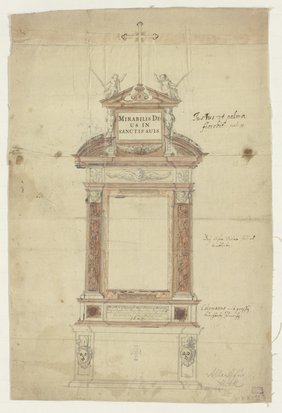A folding plan with a view of an altar for the collegiate church of the Benedictine monastery in Melk (Lower Austria) provides a direct insight into planning-historical contexts and the interaction between artist and client. The altar design by an as yet unidentified artist with two alternatives for the upper end of the gable refers to the predecessor building of the well-known High Baroque monastery church, newly built from 1701.
Since most of the older interior decoration was removed in the course of the new construction and is hardly documented, the drawing is one of the few concrete evidences of the interior of the old monastery church. Moreover, it is of cultural-historical value because it contains concrete instructions and requests for corrections that very likely originated from the client himself, the abbot of the monastery Valentin Embalner, who governed between 1637 and 1676. Embalner was one of the protagonists of the so-called "Second Melk Reform", in which especially the figure of St. Koloman as the monastery patron and local saint regained a special significance.
According to older descriptions, the altar probably stood above or next to the tumba of the martyr, who, according to legend, came from Ireland and was executed near Stockerau in 1017 during a pilgrimage to Jerusalem, marked by an elaborate arcaded canopy architecture in the late Middle Ages.
In 1647, Embalner donated not only the altar but also the matching altarpiece, which was created by the artist J. Georg Bachmann. Bachmann's copper painting depicting the Translatio of St. Koloman (the transfer of his bones to Melk) can be found today in the winter sacristy of the Melk monastery church. Its dimensions deviate slightly from the plan and it has an architectural frame that resembles the folded draft version, but is not identical. According to the entries in the plan, it is more likely that the folded-out variant shown here was realised. The extent to which parts of the altar erected in 1647 were reused remains to be clarified.
In the unfolded section of the plan, Embalner added an alternative verse in handwriting to the psalm verse in the upper text field: "Justus vt palma florebit . psal. 91". This was also to become the leading exegetical verse of the later new Koloman altar in the transept of today's monastery church, completed in 1725/26. Small corrections and additions were made to the upper cross, which was adapted to the shape of the "Melk Cross", an important reliquary of the monastery. Embalner added the year 1647 to the base inscription and commented to the right: "Colomanne mit grossen buchstaben zumachen". To the right of the image field that was to frame the image of the Translatio, he noted: "Bey dieser Vision soll es verbleiben" (It shall remain with this vision)
sp

